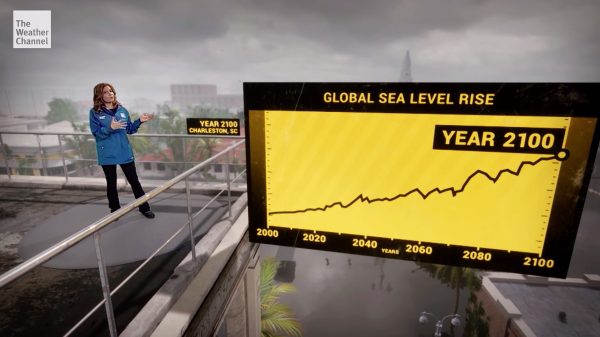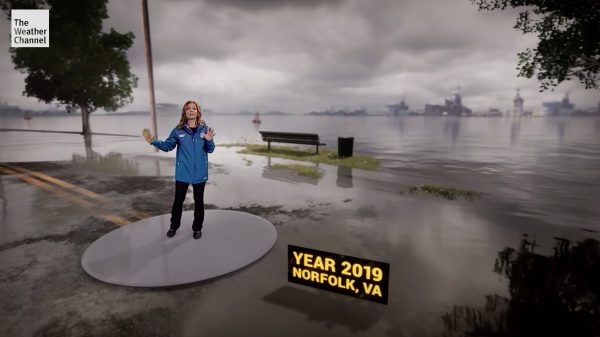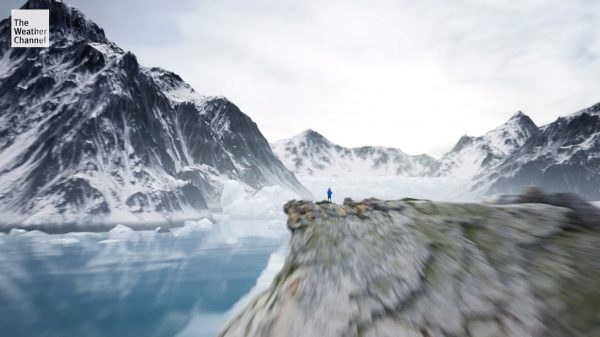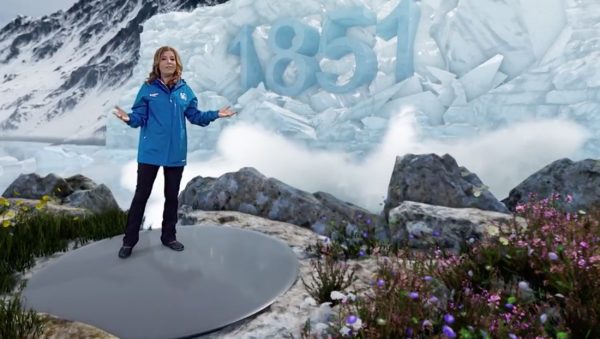The Weather Channel Unveils a New Futuristic and Terrifying Immersive Mixed Reality
Visualizing A Future Brimming with Utter Disaster
The Weather Channel is continuing with its trend of producing terrifying immersive mixed reality (IMR) creations of various natural disasters. Its latest immersive mixed reality segment transcends both time and space and transports viewers back in time and forward into the future and travels thousands of miles while explaining the effects of climate change.
The Weather Channel has partnered with The Future Group to create the IMR segment which is hosted by the meteorologist Jen Carfagno. The segment begins with Jen standing on what appears to a virtual simulation that tries to model what Charleston, South Carolina might look like 81 years from now, in the year 2100.

In the view, you will see a dilapidated billboard ad for the 2086 elections, implying that this billboard has been standing for 14 years without being changed. After all, it is the year 2100 and it’s probably not been changed because the effects of climate change have rendered these places into ghost towns and ghost cities for years.
In the Charleston in 2100 virtual rendition, you see its tree-lined streets transformed into rivers. The street lights hang just feet from the water surface and the meteorologist, now perched on a rooftop, explains to the viewer that this might be the state of Charleston in 2100 if the current tide of climate change is not reversed.
In the Weather Channel’s latest mixed reality segment, future catastrophic flooding is linked to the current melting of glaciers and the rise of sea level today. The IMR then takes another detour from the grim renditions of the future and puts the meteorologist into other virtual extreme weather events such as winter storms and hurricanes which appear highly realistic.
Some parts of the rendition focus on climate change and its impact on some of the current phenomena and natural disasters such as the worsening of the furious wildfires scorching the West Coast annually or thinning of the ice that coats the surface of lakes across the US. This is The Weather Channel’s first immersive mixed reality to completely focus on the effects of climate change.
To develop the IMR segments, The Weather Channel relied on the popular video game development portal Unreal Engine which enabled it to adjust the graphics in real time.
To create the immersive reality video, the production team used camera tracking technology and positioned the meteorologist on the scene. The end product is a very vivid and hyper-realistic cinematic scene of the renditions that is guaranteed to grab your attention and engage your sense of sight and sound. Viewing the rendition, it almost feels like an actual lived experience and vividly illustrates the story being told.

Once the IMR has previewed the future Charleston and its catastrophic floods, the meteorologist heads to another waterlogged city in the US, Norfolk in Virginia as of today. The segment will illustrate that the sea level in Norfolk has risen 1.4 feet since 1927 as the global temperatures have risen.
Just like in the Charleston floods, the IMR rendition connects the rising sea level in Norfolk to the melting of Arctic glaciers which is currently happening at a high rate due to the effects of global warming. Global warming can cause the rise of sea levels in other ways. Warm water can expand and thaw the land ice which will trickle into the ocean thereby leading to a rise in sea level. To illustrate this point, the meteorologist will explain that in West Greenland, some 25 miles of the Jakobshavn Glacier have simply vanished since 1851 and behind the glacier, a massive wall of ice is already crumbling as the glacier has been shedding its ice at a faster pace for the past two decades due to the effects of climate change.

More than half of the Arctic ice has melted so far and a UN report released last year showed that we have already passed the point of no return in terms of the melting of the glaciers. Greenland alone can account for more than 6m or 20 feet in potential sea level rise. The state of the Jakobshavn Glacier as of today paints a bleak picture of the scale of global warming problems we are likely to face in the future.

In the Weather Channel rendition, the glacial loss is illustrated vividly with Carfagno standing on top of an icy outcrop with the beginning of the Jakobshavn looming in the distance. From here, the years begin rolling back followed by a corresponding glacial growth back to its old glory in 1851, up to a point when the meteorologist finds herself within the a few feet of the frozen wall. It really brings to light the scale and terrifying pace of glacial loss over the past one and a half century.
The melting of ice and the subsequent rise in the sea level is an effect that is going to occur within our lifetime. It’s not some slow natural phenomenon whose impact takes millennia to manifest itself. This will happen in a matter of decades.
The Weather Channel team is keen on passing this message on climate change and makes a point of mentioning it during its live programming. Where they fall short in the IMR production is failing to mention and possibly illustrate how climate change and global warming is mainly caused by human activities. Neither have they included any call to action for humanity to rally behind climate action and save our planet.
However the team hopes that by showing viewers the destructive impact that climate change has had and will have on our planet in the future through grim graphics and information and helping them visualize what that future might actually look like, they will not only inform but stir a conversation and concern among the viewing public around the issue of climate change.
https://virtualrealitytimes.com/2019/04/10/the-weather-channel-unveils-a-new-futuristic-and-terrifying-immersive-mixed-reality/https://virtualrealitytimes.com/wp-content/uploads/2019/04/The-Weather-Channel-Immersive-Mixed-Reality-Image-Showing-Glacial-Loss-in-Greenland-600x339.jpghttps://virtualrealitytimes.com/wp-content/uploads/2019/04/The-Weather-Channel-Immersive-Mixed-Reality-Image-Showing-Glacial-Loss-in-Greenland-150x90.jpgMixed RealityTechnologyVisualizing A Future Brimming with Utter Disaster The Weather Channel is continuing with its trend of producing terrifying immersive mixed reality (IMR) creations of various natural disasters. Its latest immersive mixed reality segment transcends both time and space and transports viewers back in time and forward into the future and...Sam OchanjiSam Ochanji[email protected]SubscriberVirtual Reality Times - Metaverse & VR
